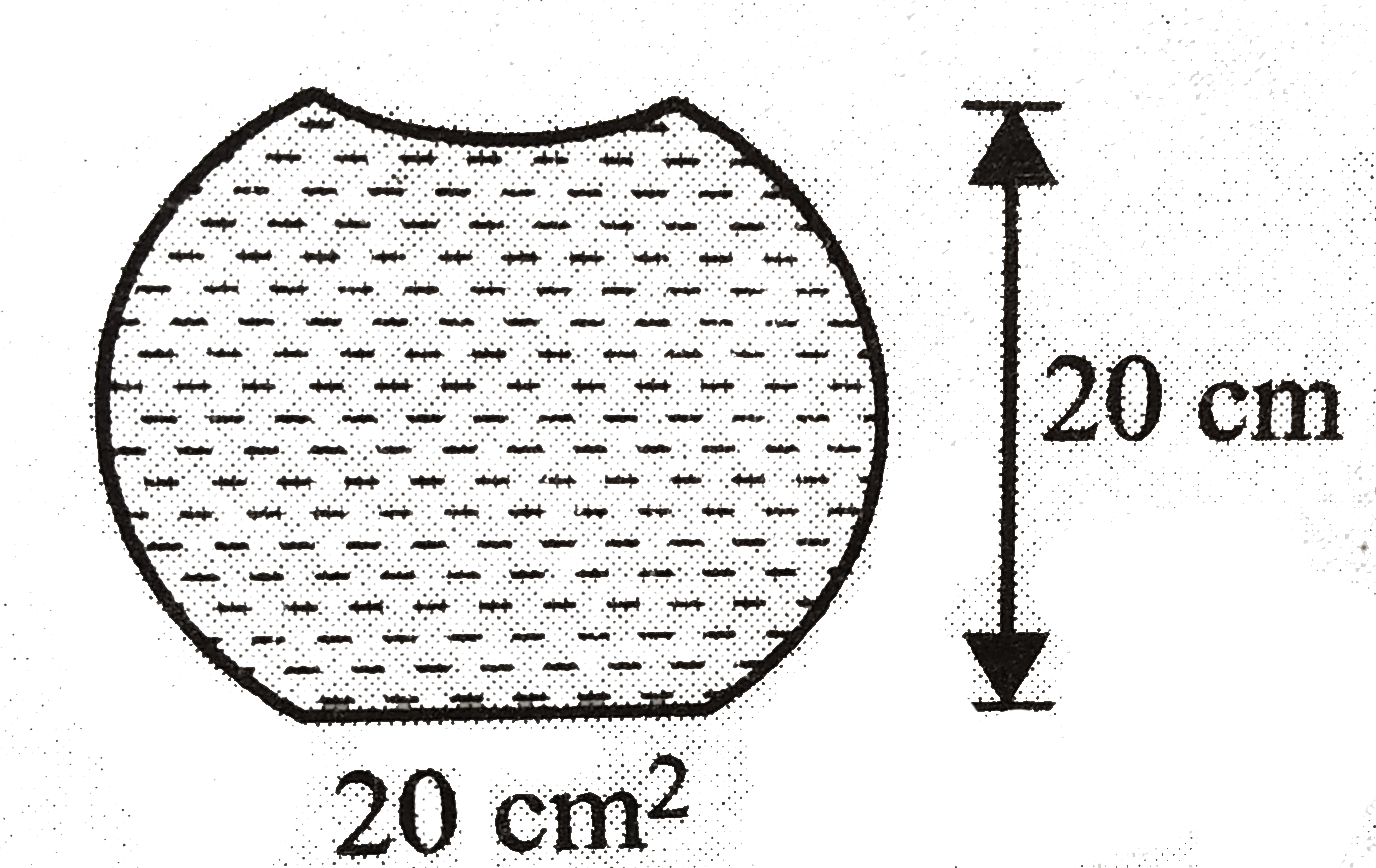Assuming that the atmosphere has a uniform density of and an effective height of 10 km, find the force exerted on an area of dimensions at the bottom of the atmosphere.
To solve the problem, we need to calculate the force exerted on an area at the bottom of the atmosphere, given the uniform density of the atmosphere, the effective height, and the dimensions of the area.
1. Identify Given Values:
- Density of the atmosphere, ρ=1.3kg/m3
- Effective height of the atmosphere, h=10km=10,000m
- Dimensions of the area: Length L=100m and Breadth B=80m
2. Calculate the Area:
A=L×B=100m×80m=8000m2
3. Calculate the Pressure at the Bottom of the Atmosphere:
- The formula for pressure P is given by:
P=ρ⋅g⋅h
- Where g (acceleration due to gravity) is approximately 9.8m/s2.
- Substituting the values:
P=1.3kg/m3×9.8m/s2×10,000m
4. Calculate the Pressure:
P=1.3×9.8×10,000=127340N/m2
5. Calculate the Force:
- The force F exerted on the area is given by:
F=P⋅A
- Substituting the values of pressure and area:
F=127340N/m2×8000m2
6. Calculate the Final Force:
F=127340×8000=1018720000N=1.01872×109N
Final Answer:
The force exerted on the area of dimensions 100m×80m at the bottom of the atmosphere is approximately 1.019×109N.
- Density of the atmosphere, ρ=1.3kg/m3
- Effective height of the atmosphere, h=10km=10,000m
- Dimensions of the area: Length L=100m and Breadth B=80m
A=L×B=100m×80m=8000m2
- The formula for pressure P is given by:
P=ρ⋅g⋅h
- Where g (acceleration due to gravity) is approximately 9.8m/s2.
- Substituting the values:
P=1.3kg/m3×9.8m/s2×10,000m
P=1.3×9.8×10,000=127340N/m2
- The force F exerted on the area is given by:
F=P⋅A
- Substituting the values of pressure and area:
F=127340N/m2×8000m2
F=127340×8000=1018720000N=1.01872×109N
The force exerted on the area of dimensions 100m×80m at the bottom of the atmosphere is approximately 1.019×109N.
Topper's Solved these Questions
- BOOK - ALLENCHAPTER - ELASTICITY, SURFACE TENSION AND FLUID MECHANICSEXERCISE - Exercise 1 (Elasticity)16videos
ELASTICITY, SURFACE TENSION AND FLUID MECHANICS
- BOOK - ALLENCHAPTER - ELASTICITY, SURFACE TENSION AND FLUID MECHANICSEXERCISE - Exercise 1 (Surface Tension)21videos
ELASTICITY, SURFACE TENSION AND FLUID MECHANICS
- BOOK - ALLENCHAPTER - CENTRE OF MASSEXERCISE - EXERCISE-V B19videos
CENTRE OF MASS
- BOOK - ALLENCHAPTER - ERROR AND MEASUREMENTEXERCISE - Part-2(Exercise-2)(B)22videos
ERROR AND MEASUREMENT
Similar Questions
Assuming that the atmosphere has the same density anywhere as at sea level (ρ=1.3kgm−3) and g to be constant (g=10ms−2). What should be the approximate height of atmosphere ?
(ρ0=1.01×105Nm−2)View SolutionSpeed of transverse wave in a string of density 100kg/m3 and area of cross-section 10mm2 under a tension of 103 N is
View Solution
Knowledge Check
- Question 1 - Select One
An adulterated sample of milk has a density 1032kgm−3 , while pure milk has a density of 1080kgm−3 . Then the volume of pure milk in a sample of 10 litres of adulterated milk is
A1 litreB2 litreC3 litreD4 litre
A beaker of circular cross-section of radius 4 cm is filled with mercury up to a height of 10 cm. Find the force exerted by the mercury on the bottom of the beaker. The atmospheric pressure =105Nm−2. Density of mercury =13600kgm−3.Takeg10ms−2
View SolutionThe density of asir ner earth's surface is 1.3kgm−3 and the atmospheric pressure is 1.0×105Nm−2. If the atmosphere had uniform density, same as that observed at the surface of the earth what would be the height of the atmosphere to exert the same pressure?
View SolutionA glass full of water upto a height of 10 cm has a bottom of are 10cm2, top of area 30cm2 and volume 1 litre.
(a) Find the force exerted by the water on the bottom.
(b) Find the resultant force exerted by the sides of the glass on the water.
(c ) If the glass is convered by a jar and the air inside the jar is completely pumped out, what will be the answer to parts (a) and (b).
(d) If a glass of different shape is used, provided the height, the bottom area, the top area and the volume are unchanged, will the answer to parts (a) and (b) change.
Take g=10m/s3, density of water=103kg/m3 and atmospheric pressure =1.01×105N/m2.View SolutionA vessel of base area 100cm×60cm and height 200cm is completely filled with a liquid of density 1.1×103kgm−3.
(a) Ignoring the atmospheric pressure, find :
(i) the thrust at the bottom of the vessel,
(ii) the pressure at the bottom of the vessel,
(iii) The pressure at a depth of 5 cm from the free surface,
(iv) the net force experienced by a metal foil of area 10cm2 placed at a depth of 5 cm from the free surface,
(b) The thrust at the bottom of the vessel if the atmospheric pressure equal to 1×105Nm−2 is taken into account.
Take g=9.8ms−2 .View SolutionPositive and negative ions are produced in the atmosphere due to cosmic rays from space and also due to radioactive elements in the soil. In some region in the atmosphere, the electric field strength is 100V/m in the vertically downward direction. This field exerts force on the positive and negative ions in the given region in atmosphere. As a result, positive ions, having a density 500/cm3 drift downward while negative ions, having a density 300/cm3 drift upward. All these ions are singly charged. It is observed that the conductivity in the given region is 4×10−13(Ω−m)−1. Find the average speed of ions, assuming it to be the same for positive and negative ions.
View SolutionA typical riverborne silt particle has a radius of 20(μ)m and a density of 2×103kg/m3. The viscosity of water is 1.0mPI. Find the terminal speed with which such a particle will settle to the bottom of a motionless volume of water.
View SolutionA glass full of water has a bottom of area 20cm2, top of area 20cm, height 20cm and volume half a litre.

a. Find the force exerted by the water on the bottom.
b. Considering the equilibrium of the v, after. find the resultant force exerted by the side, of the glass on the water. Atmospheric pressure =1.0×105N/m2. Density of water =1000kg/m−3 and g=10m/s2View Solution

